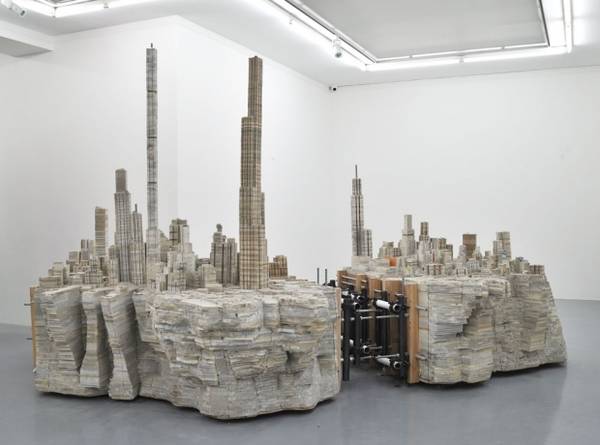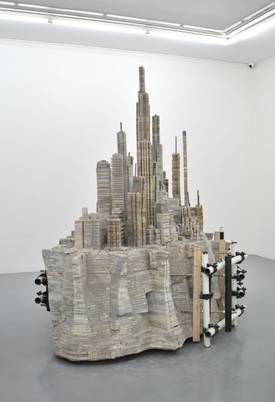[Warning: pretty depressing. -egg]
The Gray Box: An investigative look at solitary confinement – Dart Society Reports
http://www.dartsocietyreports.org/cms/2012/01/the-gray-box-an-original-investigation/
(via Instapaper)
[Warning: pretty depressing. -egg]
The Gray Box: An investigative look at solitary confinement – Dart Society Reports
http://www.dartsocietyreports.org/cms/2012/01/the-gray-box-an-original-investigation/
(via Instapaper)







Starry night expresses private spaces given by night and various emotions that are not able to be defined and described in the space. I’ve chosen analogue type for the expression which attempts to install electric bulbs in an objet to be expressed using back space of night by taking advantage of huge studio. There are two spaces in photographs. One is a space before electric bulbs of familiar landscape are installed and the other is a space after electric bulbs expressed by dispersing personal emotion are installed. Unified light from these two spaces generates a mysterious landscape.Eunyeol will be showing this series of photos at the Gana Art Space in Seoul starting this week. I want to thank @jealouqity for helping get in touch with the gallery for this post, and if you liked this, also check out the work of Barry Underwood.






















Lamar's post details other floats and costumes, including an 1884 version of the Aeneid, an 1888 Middle Ages mythos float, an 1892 tribute to fruits and vegetables, an 1895 Asgard, a 1900 Alice in Wonderland, and a 1925 Japanese mythology set.
In 1873, Mardi Gras revelers from the Mistick Krewe of Comus — unversed in this newfangled evolutionary theory and angry at the Northern interlopers — dressed up as the "missing links" between animals, plants, and humans. Therefore, you had frightening human-grape and human-corn hybrids running around and fauna baring the faces of Ulysses S. Grant, other hated politicians, and Darwin himself.
You can see these costumes here, but this being 1870s Louisiana, the masquerade was absurdly racist.
Manfred’s on the road again, making strangers rich.I re-read Charles Stross’ ACCELERANDO at least once a year. More often, I’ll return to just the first three chapters once every few months. Published in 2005, and written in serial form from 1999 to 2004 – and you can grab the whole thing for yourself, free, from this link here – ACCELERANDO is a sprawling (yet massively condensed and concentrated) piece of radical hard sf about the deep computational future. It’s also about Manfred Macx, “venture altruist,” staying ahead of the memetic curve with an exotic set of information-processing hardware. Let’s run a bit of that opening again:
It’s a hot summer Tuesday, and he’s standing in the plaza in front of the Centraal Station with his eyeballs powered up and the sunlight jangling off the canal, motor scooters and kamikaze cyclists whizzing past and tourists chattering on every side. The square smells of water and dirt and hot metal and the fart-laden exhaust fumes of cold catalytic converters; the bells of trams ding in the background, and birds flock overhead. He glances up and grabs a pigeon, crops the shot, and squirts it at his weblog to show he’s arrived. The bandwidth is good here, he realizes; and it’s not just the bandwidth, it’s the whole scene. Amsterdam is making him feel wanted already, even though he’s fresh off the train from Schiphol: He’s infected with the dynamic optimism of another time zone, another city. If the mood holds, someone out there is going to become very rich indeed.
He wonders who it’s going to be.
He glances up and grabs a pigeon, crops the shot, and squirts it at his weblog to show he’s arrived.He’s doing that with, essentially, Google Glasses and some wearable computers to beef up their utility. It’s what I’d do today with a smartphone. In fact, I last did it on Thursday. Macx’s kit is based around the glasses.
His channels are jabbering away in a corner of his head-up display, throwing compressed infobursts of filtered press releases at him. They compete for his attention, bickering and rudely waving in front of the scenery.I like to think that this bit is Bruce Sterling at age 70. That’s a man who processes a lot of press releases.
He’s ignoring the instant messenger boxes, enjoying some low-bandwidth, high-sensation time with his beer and the pigeons, when a woman walks up to him, and says his name: "Manfred Macx?"I might be the only person I know who doesn’t use IM at all. That said, this book is pre-Twitter, and I can certainly get a “please RT” vibe off that…
Being a pronoiac meme-broker is a constant burn of future shock – he has to assimilate more than a megabyte of text and several gigs of AV content every day just to stay current.I think I’ve probably gotten into the concept of agalmics and how it relates to the attention economy before now. Attention Philanthropy is the takeaway, and how this site mostly works – using whatever profile I have to direct you to works of interest. How much text do you take in every day? Is it even possible to quantify it by bytes anymore?
his glasses remind him that he’s six hours behind the moment and urgently needs to catch up.Do you ever feel like that upon waking? Six hours behind the moment. Sleeping took you off the road to the future.
He speed reads a new pop-philosophy tome while he brushes his teeth, then blogs his web throughput to a public annotation server; he’s still too enervated to finish his pre-breakfast routine by posting a morning rant on his storyboard site.Kick that one around. It contains the point that he’s not just taking in information, but processing it and excreting more information. Also, extruding it out on to a public space where people can fiddle with it. (Of course, Charlie still has comments enabled on his site. I am less sanguine about that sort of thing.)
Lying on a bench seat staring up at bridges, he’s got it together enough to file for a couple of new patents, write a diary rant, and digestify chunks of the permanent floating slashdot party for his public site. Fragments of his weblog go to a private subscriber list – the people, corporates, collectives, and bots he currently favors.I’m reminded of Bruce again, here, and the fact that his Twitter account is locked. 20,000 people are allowed to follow his account – in actual fact, the people, corporates, collectives, and bots he currently favours.
He sits in a chair, gin and tonic at hand, absorbing the latest market news and grazing his multichannel feeds in parallel. His reputation is up two percent for no obvious reason today, he notices: Odd, that.Aah, when we thought there’d be a trackable reputation economy. Cory, what damage you wrought on the poor innocent heads of the socially optimistic. Charlie himself ended up taking down Klout last year.
The metacortex – a distributed cloud of software agents that surrounds him in netspace, borrowing CPU cycles from convenient processors (such as his robot pet) – is as much a part of Manfred as the society of mind that occupies his skull; his thoughts migrate into it, spawning new agents to research new experiences, and at night, they return to roost and share their knowledge.I kind of want to mention Weavrs here – I still have to find the time to train the one I spawned last year, but (with all respect to the developers) I doubt I’ll ever be able to make it do what I want. Intelligent Agents are going to be a pipedream for a while longer, I suspect. Which makes me sad. But there’s something here – Weavrs and other software instances like Google Alerts can enact discovery, and bring us information we wouldn’t necessarily have the time or awareness to grab manually. This makes me want to spawn new sets of Google Alerts. I only have a couple running right now, for hauntology and radiophonics, which I set up a couple of years back.
"Do I know you?" he asks politely, even as he feels a shock of recognition.Not really in the flow of what I’m trying to talk about here, but: facial recognition software yoked to a contacts system hooked into a well-maintained calendar.
"Amsterdam, three years ago." The woman in the double-breasted suit raises an eyebrow at him, and his social secretary remembers her for him, whispers in his ear.
"Annette from Arianespace marketing?"
His glasses are on the breakfast bar; he pulls them on and is besieged by an urgent flurry of ideas demanding attention.Six hours behind the moment again. But this is (in part) the same experience as picking up a smartphone with notifications enabled.
"What’s life coming to when I can’t cope with the pace of change?" he asks the ceiling plaintively.Manfred is thirty when he says this. I’m forty-four.
[Incredibly interesting read. One of the darkest, weirdest corners of 60s psychedelic culture. I'm a big Jim Kweskin fan, too, although now I'm a bit creeped out. -Egg]
The Lyman Family's Holy Siege of America
http://www.dinkypage.com/lymanfamily
(via Instapaper)
George Wright Fugitive Story - Uncatchable GQ May 2012: Newsmakers: GQ
http://www.gq.com/news-politics/newsmakers/201205/george-wright-fugitive-capture-story?printable=true
(via Instapaper)
Trouble in Paradise | Culture | Vanity Fair
http://www.vanityfair.com/culture/features/2008/01/pitcairn200801?printable=true¤tPage=all
(via Instapaper)

FUJISAN plays with 2 inescapable elements of birthdays: the candle and the chocolate cake. The idea is to revisit the "fondant au chocolat" by using the candle to obtain the warm heart of the cake. Planted in the biscuit, the chocolate candle melts little by little it and fills the "crater" of the cake. So, the time of a song, the fondant gets ready under our eyes.

